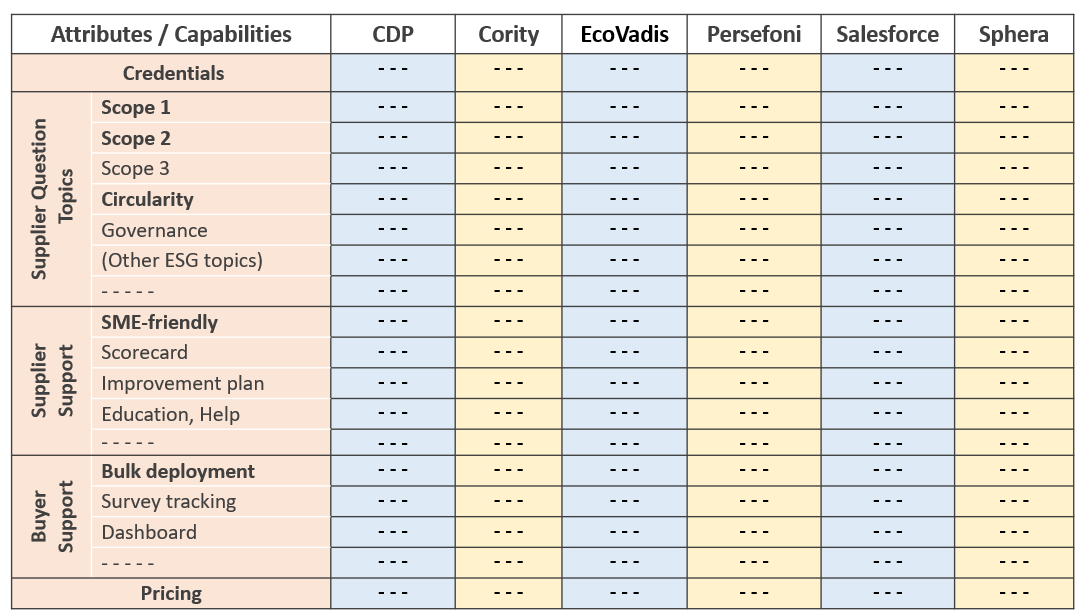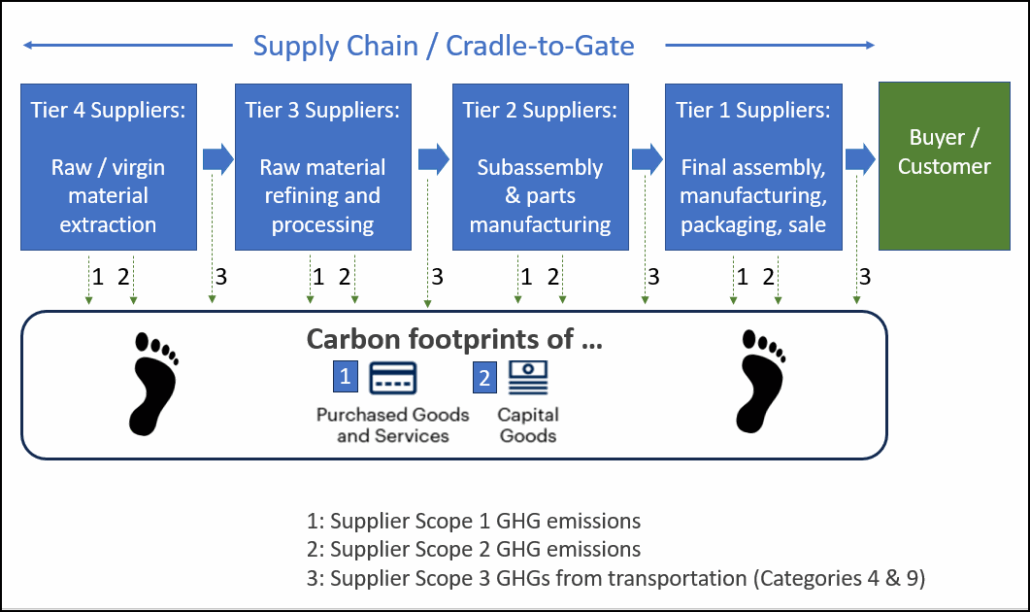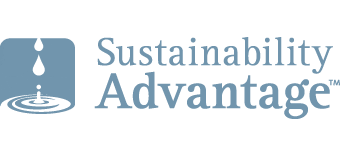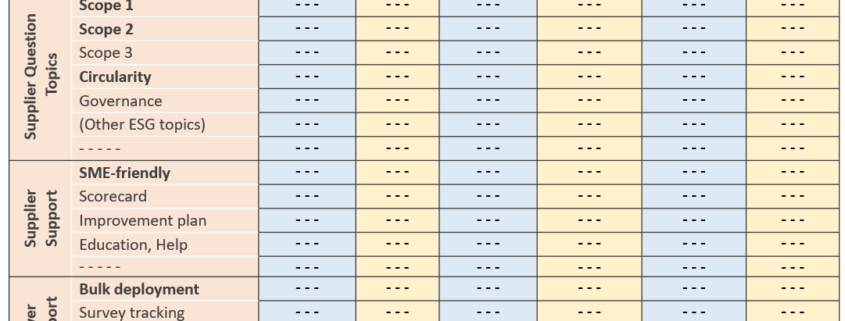Comparison of Supplier GHG Status Questionnaires

In a previous blog, I provided an overview of the free, open-source Net-Zero Procurement (NZP) Toolkit. The NZP Toolkit includes four tools, one of which is a sample supplier greenhouse gas (GHG) status assessment questionnaire. It scores suppliers on their GHG-reduction commitment, progress, and plans. The sample questionnaire in the Toolkit is the SME-friendly, Excel-based Net-Zero Ambition Assessment Tool (NZAAT). NZAAT is a good. However, an online, digitized equivalent of NZAAT may be helpful if it were to be used with hundreds or thousands of suppliers. I have done a side-by-side comparison of how six online supplier GHG questionnaires provided by CDP, Cority, EcoVadis, Persefoni, Salesforce, and Sphera meet 24 desired criteria for an online, rapidly-scalable version of NZAAT.
First, a bit of context. We are experiencing a climate crisis. Too many businesses are sitting on the sidelines waiting for governments to fix the climate emergency. The dismal track record of 28 annual Conference of the Parties (COPs) shows that’s not going to happen. Businesses account for over 80% of greenhouse gas (GHG) emissions, not governments. Unless all businesses – including small- and medium-sized business / enterprises (SMEs) that account for 51% of businesses’ GHG emissions – are actively engaged in reducing their GHGs, the climate emergency will get worse. All businesses are suppliers. Net-Zero Procurement (NZP) uses the buying power of customers in the public, private, and academic sectors as a market force to engage suppliers / businesses in the race to net-zero.
Scoring suppliers on their GHG-reduction commitment, efforts, and plans, and making that score matter, is the signature feature of Net-Zero Procurement. It financially motivates suppliers to reduce their product carbon footprints and their GHGs because they earn more points if they have a higher score, giving them a competitive advantage over other bidders. There are several questionnaires that score suppliers’ commitment to, and progress toward, science-based net-zero targets. (e.g., CDP, the UN’s Race to Zero, SBTi, Canada’s Net-Zero Challenge). However, some of these frameworks may be challenging for SMEs. SMEs comprise over 99% of the companies on the planet, so they comprise the majority of any organization’s suppliers. Therefore, we need an SME-friendly, yet comprehensive, tool that assesses the status of a supplier’s GHG reduction efforts. The Net-Zero Ambition Assessment Tool (NZAAT) does that. Based on questions asked by the above questionnaires, it uses multiple-choice questions to score the organization’s commitment to, and progress toward, science-based net-zero targets and to circularity. It also suggests over three dozen supplier actions that would reduce their Scope 1, 2, and 3 GHG emissions.
NZAAT is good. It’s free, open-source and written in Excel, so it can be tailored by customers to suit their purposes. Customers / buyers could immediately use it in all tenders from now on. That is, any supplier responding to a future tender would be asked to answer the NZAAT questionnaire. The resulting score would be used to determine what percentage of the significant points allocated to this supplier criterion in the bid appraisal are earned by the supplier – see this blog about the Net-Zero Procurement Toolkit for more explanation of this approach and the tools that enable it.
However, some suppliers, especially SMEs, might be daunted by questions about their Scope 1, 2, and 3 GHG emissions. They may not have paid attention to their GHG emissions yet, and are ill-prepared to answers questions about them under the pressure of a deadline when responding to a request for proposal (RFP).
To be fair to those suppliers, customers could send NZAAT to all their suppliers now and signal that the questionnaire will be part of all tenders from now on. That would incentivize suppliers to complete the questionnaire as a dry run, without the pressure of an RFP deadline. Suppliers could then take action to improve their scores before the customer issues a supplier-relevant RFP, at which time they will given an opportunity to update their answers to the same questions, as part of their RFP response.
Suppliers’ answers would also serve as a timely comprehensive diagnostic to help customers see how / if they can collaborate with their suppliers on their GHG reduction efforts. If the customer is a government with GHG reduction targets for its jurisdiction, it immediately engages businesses / suppliers to help reach those targets, rather than postponing that engagement until the supplier bids on a future tender. Plus, customers are accountable for the carbon footprint of purchased products. When suppliers reduce their Scope 1, 2, and 3 GHG emissions, they reduce their product’s carbon footprint, as shown in this figure.

Suppose customers decide to go ahead and give all their suppliers a heads-up by sending them the GHG questionnaire now. NZAAT is an Excel-based questionnaire. Blasting it out to hundreds or thousands of suppliers in the supplier/vendor database, tracking responses, sending reminders, and consolidating the responses into insightful dashboards could be challenging. Some customers may already have the capacity to use their supplier relationship management system to manage and track suppliers’ questionnaire responses and to use Excel’s Power Query and Pivot Tables functions to consolidate and visualize results in a tailorable dashboard. Other customers might opt to convert NZAAT into a cloud-based software platform like Qualtrics which allows users to create, distribute, manage, and analyze surveys, all within the same platform. However, many customers might prefer to use a ready-made NZAAT-equivalent online tool.
I discovered several such existing online tools when I was exploring what it would take to convert NZAAT into an online questionnaire. Several platform providers claimed they already had similar supplier GHG questionnaires. A few years ago, the Sustainable Purchasing Leadership Council (SPLC) issued a whitepaper, “Landscape Review: Supply Chain Greenhouse Gas Emissions Tools for Purchasers,” which provided SPLC members with an initial overview of three such tools. I am on the board of SPLC, so I had access to the whitepaper. I have built on it by developing a comparison of six potential online equivalents of NZAAT that are provided by CDP, EcoVadis, Salesforce, Persefoni, Cority and Sphera. The side-by-side comparison identifies 24 desired capabilities of the online tool and provides an initial “self-evaluation” by the six tool providers of how well their offering satisfies each criterion. The comparison can be leveraged as a customizable scorecard template for evaluating which online supplier GHG questionnaire might work best for a particular customer’s purposes and situation.
The comparison is downloadable from the NZAAT webpage. Check it out. If any of you have experience with the six resources reviewed, I would value your suggestions on how to tweak the descriptions of their capabilities.
As described above, there is a good suite of questionnaires that could be used to score suppliers on their GHG reduction efforts. Their use by customers with their suppliers may be our best bet to engage businesses in reducing their GHGs in time to address the climate emergency. I urge you to select the questionnaire approach that works best for your organization, pilot it, and deploy it as you integrate Net-Zero Procurement elements into your current procurement system. Times a-wastin’.
Note: Figures in this blog are from slides in my Master Slide Decks, to which anyone can subscribe. For blog subscribers, please click here to visit my site and provide feedback.




